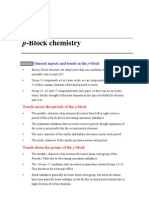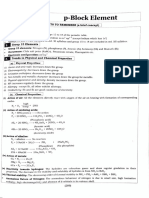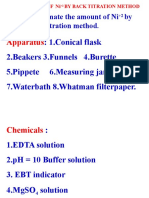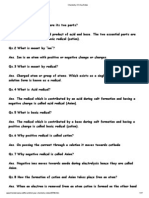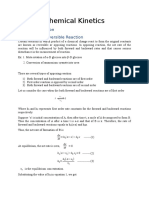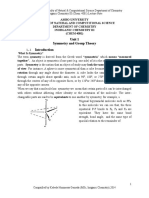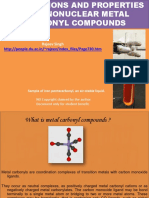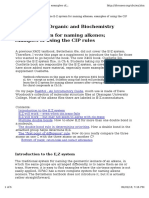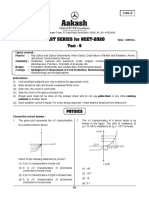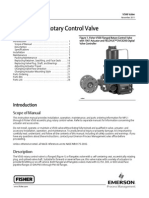Professional Documents
Culture Documents
EZ & RS Nomenclature
Uploaded by
pulkit asatiOriginal Description:
Original Title
Copyright
Available Formats
Share this document
Did you find this document useful?
Is this content inappropriate?
Report this DocumentCopyright:
Available Formats
EZ & RS Nomenclature
Uploaded by
pulkit asatiCopyright:
Available Formats
By – Dr. Vikash K.
Mishra
E-Z NOTATION FOR GEOMETRIC ISOMERISM
The E-Z system
The problem with the cis-trans system for naming geometric isomers
Consider a simple case of geometric isomerism which we've already discussed on
the previous page.
You can tell which is the cis and which the trans form just by looking at them. All
you really have to remember is that trans means "across" (as in transatlantic or
transcontinental) and that cis is the opposite. It is a simple and visual way of telling
the two isomers apart. So why do we need another system?
There are problems as compounds get more complicated. For example, could you
name these two isomers using cis and trans?
Because everything attached to the carbon-carbon double bond is different, there
aren't any obvious things which you can think of as being "cis" or "trans" to each
other. The E-Z system gets around this problem completely - but unfortunately
makes things slightly more difficult for the simple examples you usually meet in
introductory courses.
How the E-Z system works
We'll use the last two compounds as an example to explain how the system works.
You look at what is attached to each end of the double bond in turn, and give the
two groups a "priority" according to a set of rules which we'll explore in a minute.
In the example above, at the left-hand end of the bond, it turns out that bromine
has a higher priority than fluorine. And on the right-hand end, it turns out that
chlorine has a higher priority than hydrogen.
SIPS, Sagar (MP) Page 1
By – Dr. Vikash K. Mishra
If the two groups with the higher priorities are on the same side of the double bond,
that is described as the (Z)- isomer. So you would write it as (Z)-name of
compound. The symbol Z comes from a German word (zusammen) which means
together.
If the two groups with the higher priorities are on opposite sides of the double
bond, then this is the (E)- isomer. E comes from the German entgegen which
means opposite.
So the two isomers are:
Summary
(E)- : the higher priority groups are on opposite sides of the double bond.
(Z)- : the higher priority groups are on the same side of the double bond.
E-Z notation
E-Z configuration, or the E-Z convention, is the IUPAC preferred method of describing
the absolute stereochemistry of double bonds in organic chemistry. It is an extension of cis–trans isomer
notation (which only describes relative stereochemistry) that can be used to describe double bonds having
two, three or four substituents.
Following the Cahn–Ingold–Prelog priority rules (CIP rules), each substituent on a double bond is assigned
a priority.
If the two groups of higher priority are on opposite sides of the double bond, the bond is assigned the
configuration E (from entgegen, German: [ɛntˈɡeːɡən], the German word for "opposite").
If the two groups of higher priority are on the same side of the double bond, the bond is assigned the
configuration Z (from zusammen, German: [tsuˈzamən], the German word for "together").
What is EZ nomenclature?
It is an extension of cis/trans notation (which only describes relative stereochemistry) that can be used to
describe double bonds having two, three or four substituents. Following the Cahn–Ingold–Prelog priority
rules (CIP rules), each substituent on a double bond is assigned a priority.
SIPS, Sagar (MP) Page 2
By – Dr. Vikash K. Mishra
Is E or Z cis or trans?
Thus the two priority groups are on opposite sides = entgegen = E. This example should convince you
that cis and Z are not synonyms. Cis/trans and E,Z are determined by distinct criteria. There may seem to
be a simple correspondence, but it is not a rule.
The E-Z system for naming alkenes
The traditional system for naming the geometric isomers of an alkene, in which the same groups are
arranged differently, is to name them as cis or trans. However, it is easy to find examples where the cis-
trans system is not easily applied. IUPAC has a more complete system for naming alkene isomers. The R-
S system is based on a set of "priority rules", which allow you to rank any groups. The rigorous IUPAC
system for naming alkene isomers, called the E-Z system, is based on the same priority rules.These priority
rules are often called the Cahn-Ingold-Prelog (CIP) rules, after the chemists who developed the system
The general strategy of the E-Z system is to analyze the two groups at each end of the double bond. At
each end, rank the two groups, using the CIP priority rules. Then, see whether the higher priority group at
one end of the double bond and the higher priority group at the other end of the double bond are on
the same side (Z, from German zusammen = together) or on opposite sides (E, from German entgegen =
opposite) of the double bond.
EXAMPLE 1: BUTENE
The Figure below shows the two isomers of 2-butene. You should recognize them as cis and trans. Let's
analyze them to see whether they are E or Z.
Start with the left hand structure (the cis isomer). On C2 (the left end of the double bond), the two atoms
attached to the double bond are C and H. By the CIP priority rules, C is higher priority than H (higher
atomic number). Now look at C3 (the right end of the double bond). Similarly, the atoms are C and H, with
C being higher priority. We see that the higher priority group is "down" at C2 and "down" at C3. Since the
two priority groups are both on the same side of the double bond ("down", in this case), they are
zusammen = together. Therefore, this is (Z)-2-butene.
Now look at the right hand structure (the trans isomer). In this case, the priority group is "down" on the left
end of the double bond and "up" on the right end of the double bond. Since the two priority groups are
on opposite sides of the double bond, they are entgegen = opposite. Therefore, this is (E)-2-butene.
E,Z will always work, even when cis,trans fails
In simple cases, such as 2-butene, Z corresponds to cis and E to trans. However, that is not a rule. This
section and the following one illustrate some idiosyncrasies that happen when you try to compare the two
systems. The real advantage of the E-Z system is that it will always work. In contrast, the cis-trans system
breaks down with many ambiguous cases.
EXAMPLE 2
The following figure shows two isomers of an alkene with four different groups on the double bond, 1-
bromo-2-chloro-2-fluoro-1-iodoethene.
SIPS, Sagar (MP) Page 3
By – Dr. Vikash K. Mishra
It should be apparent that the two structures shown are distinct chemicals. However, it is impossible to
name them as cis or trans. On the other hand, the E-Z system works fine... Consider the left hand structure.
On C1 (the left end of the double bond), the two atoms attached to the double bond are Br and I. By the
CIP priority rules, I is higher priority than Br (higher atomic number). Now look at C2. The atoms are Cl and
F, with Cl being higher priority. We see that the higher priority group is "down" at C1 and "down" at C2.
Since the two priority groups are both on the same side of the double bond ("down", in this case), they are
zusammen = together. Therefore, this is the (Z) isomer. Similarly, the right hand structure is (E).
E,Z will work, but may not agree with cis,trans
Consider the molecule shown at the left.
This is 2-bromo-2-butene -- ignoring the geometric isomerism for now. Cis or trans? This molecule is clearly
cis. The two methyl groups are on the same side. More rigorously, the "parent chain" is cis.
E or Z? There is a methyl at each end of the double bond. On the left, the methyl is the high priority group --
because the other group is -H. On the right, the methyl is the low priority group -- because the other group
is -Br. That is, the high priority groups are -CH3 (left) and -Br (right). Thus the two priority groups are on
opposite sides = entgegen = E.
Multiple double bonds
If the compound contains more than one double bond, then each one is analyzed and declared to be E or
Z.
EXAMPLE 3
The configuration at the left hand double bond is E; at the right hand double bond it is Z. Thus this
compound is (1E,4Z)-1,5-dichloro-1,4-hexadiene.
The double-bond rule in determining priorities
EXAMPLE 4
Consider the compound below:
SIPS, Sagar (MP) Page 4
By – Dr. Vikash K. Mishra
This is 1-chloro-2-ethyl-1,3-butadiene -- ignoring, for the moment, the geometric isomerism. There is no
geometric isomerism at the second double bond, at 3-4, because it has 2 H at its far end.
What about the first double bond, at 1-2? On the left hand end, there is H and Cl; Cl is higher priority (by
atomic number). On the right hand end, there is -CH2-CH3 (an ethyl group) and -CH=CH2 (a vinyl or ethenyl
group). Both of these groups have C as the first atom, so we have a tie so far and must look further. What
is attached to this first C? For the ethyl group, the first C is attached to C, H, and H. For the ethenyl group,
the first C is attached to a C twice, so we count it twice; therefore that C is attached to C, C, H. CCH is
higher than CHH; therefore, the ethenyl group is higher priority. Since the priority groups, Cl and ethenyl,
are on the same side of the double bond, this is the Z-isomer; the compound is (Z)-1-chloro-2-ethyl-1,3-
butadiene.
The "first point of difference" rule
Which is higher priority, by the CIP rules: a C with an O and 2 H attached to it or a C with three C? The first
C has one atom of high priority but also two atoms of low priority. How do these "balance out"? Answering
this requires a clear understanding of how the ranking is done. The simple answer is that the first point of
difference is what matters; the O wins.
To illustrate this, consider the molecule at the left. Is the double bond here E or Z? At the left end of the
double bond, Br > H. But the right end of the double bond requires a careful analysis.
At the right hand end, the first atom attached to the double bond is a C at each position. A tie, so we look at
what is attached to this first C. For the upper C, it is CCC (since the triple bond counts three times). For the
lower C, it is OHH -- listed in order from high priority atom to low. OHH is higher priority than CCC, because
of the first atom in the list. That is, the O of the lower group beats the C of the upper group. In other words,
the O is the highest priority atom of any in this comparison; thus the O "wins".
Therefore, the high priority groups are "up" on the left end (the -Br) and "down" on the right end (the -CH2-
O-CH3). This means that the isomer shown is opposite = entgegen = E. And what is the name? The "name"
feature of ChemSketch says it is (2E)-2-(1-bromoethylidene)pent-3-ynyl methyl ether.
SIPS, Sagar (MP) Page 5
By – Dr. Vikash K. Mishra
Cahn-Ingold Prelog Rules
To name the enantiomers of a compound unambiguously, their names must include the "handedness" of
the molecule. The method for this is formally known as R/S nomenclature.
Introduction
The method of unambiguously assigning the handedness of molecules was originated by three chemists:
R.S. Cahn, C. Ingold, and V. Prelog and, as such, is also often called the Cahn-Ingold-Prelog rules. In
addition to the Cahn-Ingold system, there are two ways of experimentally determining the absolute
configuration of an enantiomer:
1. X-ray diffraction analysis. Note that there is no correlation between the sign of rotation and the
structure of a particular enantiomer.
2. Chemical correlation with a molecule whose structure has already been determined via X-ray
diffraction.
However, for non-laboratory purposes, it is beneficial to focus on the R/S system. The sign of optical
rotation, although different for the two enantiomers of a chiral molecule,at the same
temperature, cannot be used to establish the absolute configuration of an enantiomer; this is because the
sign of optical rotation for a particular enantiomer may change when the temperature changes.
Stereocenters are labeled R or S
The "right hand" and "left hand" nomenclature is used to name the enantiomers of a chiral compound. The
stereocenters are labeled as R or S.
Consider the first picture: a curved arrow is drawn from the highest priority (1) substituent to the lowest
priority (4) substituent. If the arrow points in a counterclockwise direction (leftwhen leaving the 12 o' clock
position), the configuration at stereocenter is considered S ("Sinister" → Latin= "left"). If, however, the
arrow points clockwise,(Right when leaving the 12 o' clock position) then the stereocenter is
labeled R ("Rectus" → Latin= "right"). The R or S is then added as a prefix, in parenthesis, to the name of
the enantiomer of interest.
EXAMPLE 1
(R)-2-Bromobutane
(S)-2,3- Dihydroxypropanal
SIPS, Sagar (MP) Page 6
By – Dr. Vikash K. Mishra
Sequence rules to assign priorities to substituents
Before applying the R and S nomenclature to a stereocenter, the substituents must be prioritized according
to the following rules:
Rule 1
First, examine at the atoms directly attached to the stereocenter of the compound. A substituent with a
higher atomic number takes precedence over a substituent with a lower atomic number. Hydrogen is the
lowest possible priority substituent, because it has the lowest atomic number.
1. When dealing with isotopes, the atom with the higher atomic mass receives higher priority.
2. When visualizing the molecule, the lowest priority substituent should always point away from the
viewer (a dashed line indicates this). To understand how this works or looks, imagine that a clock
and a pole. Attach the pole to the back of the clock, so that when when looking at the face of the
clock the pole points away from the viewer in the same way the lowest priority substituent should
point away.
3. Then, draw an arrow from the highest priority atom to the 2nd highest priority atom to the 3rd
highest priority atom. Because the 4th highest priority atom is placed in the back, the arrow should
appear like it is going across the face of a clock. If it is going clockwise, then it is an R-enantiomer; If
it is going counterclockwise, it is an S-enantiomer.
When looking at a problem with wedges and dashes, if the lowest priority atom is not on the dashed line
pointing away, the molecule must be rotated.
Remember that
Wedges indicate coming towards the viewer.
Dashes indicate pointing away from the viewer.
Rule 2
If there are two substituents with equal rank, proceed along the two substituent chains until there is a point
of difference. First, determine which of the chains has the first connection to an atom with the highest
priority (the highest atomic number). That chain has the higher priority.
If the chains are similar, proceed down the chain, until a point of difference.
For example: an ethyl substituent takes priority over a methyl substituent. At the connectivity of the
stereocenter, both have a carbon atom, which are equal in rank. Going down the chains, a methyl has only
has hydrogen atoms attached to it, whereas the ethyl has another carbon atom. The carbon atom on the
ethyl is the first point of difference and has a higher atomic number than hydrogen; therefore the ethyl takes
priority over the methyl.
SIPS, Sagar (MP) Page 7
By – Dr. Vikash K. Mishra
Rule 3
If a chain is connected to the same kind of atom twice or three times, check to see if the atom it is
connected to has a greater atomic number than any of the atoms that the competing chain is connected to.
If none of the atoms connected to the competing chain(s) at the same point has a greater atomic
number: the chain bonded to the same atom multiple times has the greater priority
If however, one of the atoms connected to the competing chain has a higher atomic number: that
chain has the higher priority.
EXAMPLE 2
A 1-methylethyl substituent takes precedence over an ethyl substituent. Connected to the first carbon atom,
ethyl only has one other carbon, whereas the 1-methylethyl has two carbon atoms attached to the first; this
is the first point of difference. Therefore, 1-methylethyl ranks higher in priority than ethyl, as shown below:
However:
Remember that being double or triple bonded to an atom means that the atom is connected to the same
atom twice. In such a case, follow the same method as above.
SIPS, Sagar (MP) Page 8
By – Dr. Vikash K. Mishra
Caution!!
Keep in mind that priority is determined by the first point of difference along the two similar substituent
chains. After the first point of difference, the rest of the chain is irrelevant.
When looking for the first point of difference on similar substituent chains, one may encounter branching. If
there is branching, choose the branch that is higher in priority. If the two substituents have similar
branches, rank the elements within the branches until a point of difference.
After all your substituents have been prioritized in the correct manner, you can now name/label the
molecule R or S.
1. Put the lowest priority substituent in the back (dashed line).
2. Proceed from 1 to 2 to 3. (it is helpful to draw or imagine an arcing arrow that goes from 1--> 2-->3)
3. Determine if the direction from 1 to 2 to 3 clockwise or counterclockwise.
i) If it is clockwise it is R.
ii) if it is counterclockwise it is S.
SIPS, Sagar (MP) Page 9
By – Dr. Vikash K. Mishra
USE YOUR MODELING KIT: Models assist in visualizing the structure. When using a model, make sure
the lowest priority is pointing away from you. Then determine the direction from the highest priority
substituent to the lowest: clockwise (R) or counterclockwise (S).
IF YOU DO NOT HAVE A MODELING KIT: remember that the dashes mean the bond is going into the
screen and the wedges means that bond is coming out of the screen. If the lowest priority bond is not
pointing to the back, mentally rotate it so that it is. However, it is very useful when learning organic
chemistry to use models.
If you have a modeling kit use it to help you solve the following practice problems.
Problems
Are the following R or S?
Solutions
1. S: I > Br > F > H. The lowest priority substituent, H, is already going towards the back. It turns left
going from I to Br to F, so it's a S.
2. R: Br > Cl > CH3 > H. You have to switch the H and Br in order to place the H, the lowest priority, in
the back. Then, going from Br to Cl, CH3 is turning to the right, giving you a R.
3. Neither R or S: This molecule is achiral. Only chiral molecules can be named R or S.
4. R: OH > CN > CH2NH2 > H. The H, the lowest priority, has to be switched to the back. Then, going
from OH to CN to CH2NH2, you are turning right, giving you a R.
5. (5) S: −COOH−COOH > −CH2OH−CH2OH > C≡CHC≡CH > HH. Then, going
from −COOH−COOH to −CH2OH−CH2OH to −C≡CH−C≡CH you are turning left, giving you a S
configuration.
SIPS, Sagar (MP) Page 10
You might also like
- 01.coordination Chemistry Class Notes Part I-1 PDFDocument86 pages01.coordination Chemistry Class Notes Part I-1 PDFShadrack Peter100% (1)
- Stereoselective and Stereospecific ReactionsDocument20 pagesStereoselective and Stereospecific ReactionsHunzalaNo ratings yet
- UNIT III - PhotochemistryDocument27 pagesUNIT III - PhotochemistrykuthappadyNo ratings yet
- PMR Spectroscopy: Solved Problems Volume : IIFrom EverandPMR Spectroscopy: Solved Problems Volume : IIRating: 5 out of 5 stars5/5 (3)
- Octant Rule, Axial Haloketone Rule GoodDocument11 pagesOctant Rule, Axial Haloketone Rule Goodsaheedvk50% (4)
- 11 Worksheet HydrocarbonDocument2 pages11 Worksheet HydrocarbonAakif RazaNo ratings yet
- Pericyclic Reactions Lecture NotesDocument2 pagesPericyclic Reactions Lecture Notesveluselvamani100% (3)
- Chapter 11 (Thermochemistry)Document41 pagesChapter 11 (Thermochemistry)Muhammad Nawaz Khan AbbasiNo ratings yet
- Electronic Effects & Applications - Jee (Main)Document52 pagesElectronic Effects & Applications - Jee (Main)Resonance Dlpd87% (109)
- Solubility Questions and AnswersDocument2 pagesSolubility Questions and AnswersBrittany100% (2)
- Cigre Guidelines For Life Management Techniques For Power Transformers PDFDocument125 pagesCigre Guidelines For Life Management Techniques For Power Transformers PDFJorge Bejarano100% (2)
- SKO 3013 B O C: Asic Rganic HemistryDocument53 pagesSKO 3013 B O C: Asic Rganic HemistryLuxemberg Ng100% (1)
- P Block NotesDocument21 pagesP Block NotesNcnagesh Prasad60% (5)
- Haloalkanes and Haloarenes Class 12 Chemistry MCQs PDFDocument33 pagesHaloalkanes and Haloarenes Class 12 Chemistry MCQs PDFSanjana Sanjay100% (1)
- Entropy Change in Reversible and Irreversible ProcessesDocument8 pagesEntropy Change in Reversible and Irreversible ProcessesAbeer BasharatNo ratings yet
- Hydrolysis Constant by ConducatnceDocument8 pagesHydrolysis Constant by ConducatncenavjotNo ratings yet
- Phase Transfer CatalystDocument6 pagesPhase Transfer CatalystPMH100% (3)
- Octant RuleDocument16 pagesOctant RuleRahul Sharma100% (2)
- P Block Elements MHT CET Synopsis PDFDocument15 pagesP Block Elements MHT CET Synopsis PDFAbhishek Mandlik50% (2)
- Photochemistry of Carbonil Compound1Document16 pagesPhotochemistry of Carbonil Compound1Naveen Agarwal100% (1)
- 12 Chemistry MCQ CH 5Document95 pages12 Chemistry MCQ CH 5Anshika Tripathi100% (1)
- Chemistry - MCQDocument30 pagesChemistry - MCQjoydeep_d32320% (1)
- Coordination Compounds (Exercise+Answers)Document32 pagesCoordination Compounds (Exercise+Answers)HanukkahNo ratings yet
- Case Study Ques. of Haloalkanes and HaloarenesDocument3 pagesCase Study Ques. of Haloalkanes and HaloarenesAryan SharmaNo ratings yet
- To Estimate The Amount of Ni by Using Back Titration MethodDocument15 pagesTo Estimate The Amount of Ni by Using Back Titration MethodMidde SridharNo ratings yet
- P Block Elements-Group 16Document41 pagesP Block Elements-Group 16Sanskriti Keshkar100% (5)
- Chemical EquilibriumDocument24 pagesChemical Equilibriumunbeatableamrut100% (1)
- Interview Questions For ChemistryDocument3 pagesInterview Questions For ChemistryJabeenAhmedNo ratings yet
- Dr. Muhammad Yasir Akram: Presented ToDocument19 pagesDr. Muhammad Yasir Akram: Presented ToZee ShanNo ratings yet
- Debye Huckel TheoryDocument18 pagesDebye Huckel TheoryShahidKapoor67% (3)
- Chemistry of 1,3-DithianeDocument25 pagesChemistry of 1,3-DithianeShivaprasad Hs83% (6)
- Hyperconjugation: - Devyani JoshiDocument21 pagesHyperconjugation: - Devyani JoshiEisha SaleemNo ratings yet
- Revision Notes For Class 12 CBSE Chemistry, Amines - TopperlearningDocument11 pagesRevision Notes For Class 12 CBSE Chemistry, Amines - TopperlearningRishabh BhandariNo ratings yet
- Organic Comp - Distinguish TestsDocument1 pageOrganic Comp - Distinguish TestsKatniss TathagataNo ratings yet
- Chemistry XII Viva NotesDocument17 pagesChemistry XII Viva NotesCash Cash Cash44% (9)
- Effective Nuclear Charge, Penetration, Orbital Energy PDFDocument6 pagesEffective Nuclear Charge, Penetration, Orbital Energy PDFAtul Gautam100% (1)
- Applications of NMR Spectroscopy in Inorganic ChemistryDocument11 pagesApplications of NMR Spectroscopy in Inorganic ChemistryDhanaswamy Ilangeswaran92% (12)
- Chemical EquilibriumDocument44 pagesChemical Equilibriumtarsem jiNo ratings yet
- NMR - Multiple Choice QuestionsDocument71 pagesNMR - Multiple Choice QuestionsOmSilence265171% (31)
- Spectroscopy NotesDocument19 pagesSpectroscopy NotesNeerajNo ratings yet
- Chemistry of Transition and Inner Transition Elements+.Document60 pagesChemistry of Transition and Inner Transition Elements+.Nidhi Singh75% (4)
- Opposites Attract and Like Repel.: Inductive Effect Resonance EffectDocument12 pagesOpposites Attract and Like Repel.: Inductive Effect Resonance EffectAwais Arshad0% (1)
- Coordination ChemistryDocument33 pagesCoordination ChemistryGOVIND RANJAN80% (5)
- Aliphatic Electrophilic Substitution ReactionsDocument16 pagesAliphatic Electrophilic Substitution ReactionsDhanaswamy Ilangeswaran88% (74)
- Exams Organic Chemistry MITDocument333 pagesExams Organic Chemistry MITn2h_spNo ratings yet
- Viva Questions TITRATION (Volumetric Analysis, Experiment 1 and 2) Grade XiiDocument2 pagesViva Questions TITRATION (Volumetric Analysis, Experiment 1 and 2) Grade XiiKeshav0% (1)
- Chemical Kinetics: Complex Reaction Opposing or Reversible ReactionDocument2 pagesChemical Kinetics: Complex Reaction Opposing or Reversible ReactionSowmya Roopesh B. P100% (1)
- CLS Aipmt 18 19 XII Che Study Package 7 SET 2 Chapter 13Document32 pagesCLS Aipmt 18 19 XII Che Study Package 7 SET 2 Chapter 13Rohit Pal100% (2)
- Charge Transfer SpectraDocument17 pagesCharge Transfer Spectraramukaka91% (11)
- Synthetic ReagentsDocument75 pagesSynthetic ReagentsBapu Thorat100% (1)
- Bahl and Bahl Organic Chemistry Chapter 11 To 15Document121 pagesBahl and Bahl Organic Chemistry Chapter 11 To 15Boago DrBiz DihutsoNo ratings yet
- Iupac Rules and Practice Sheet With Answers 1 PDFDocument24 pagesIupac Rules and Practice Sheet With Answers 1 PDFTara Singh100% (2)
- Reaction IntermediatesDocument12 pagesReaction IntermediatesJoya Bhatiagharu100% (3)
- 411 Unit 1symmetry and Group Theory-NoteDocument15 pages411 Unit 1symmetry and Group Theory-Notekiya01No ratings yet
- Boranes and CarboranesDocument21 pagesBoranes and CarboranesDr. Md. Ehtesham Ul Hoque50% (2)
- Chemistry Class 11 Chapter 4 Chemical Bonding and Molecular StructureDocument18 pagesChemistry Class 11 Chapter 4 Chemical Bonding and Molecular StructureAnurag Singh Tomar50% (2)
- Atomic Structure and Chemical BondingDocument17 pagesAtomic Structure and Chemical BondingHaresh ChaudhariNo ratings yet
- Preparations and Properties of Mononuclear Metal Carbonyl CompoundsDocument18 pagesPreparations and Properties of Mononuclear Metal Carbonyl CompoundsVigyan Pravaha100% (3)
- Introductory Organic and Biochemistry The E-Z System For Naming Alkenes Examples of Using The CIP RulesDocument5 pagesIntroductory Organic and Biochemistry The E-Z System For Naming Alkenes Examples of Using The CIP RulesokayyyNo ratings yet
- Conformation & Conformational IsomersDocument4 pagesConformation & Conformational Isomerspulkit asatiNo ratings yet
- Course OfferedDocument1 pageCourse Offeredpulkit asatiNo ratings yet
- Index: Physical ChemistryDocument9 pagesIndex: Physical Chemistrypulkit asatiNo ratings yet
- 3,5-Dinitrobenzoic AcidDocument3 pages3,5-Dinitrobenzoic Acidpulkit asatiNo ratings yet
- Drug Development and ApprovalDocument16 pagesDrug Development and Approvalpulkit asatiNo ratings yet
- Test Series For Neet-2020Document16 pagesTest Series For Neet-2020kavyareddyNo ratings yet
- Polymer Carrer 12Document33 pagesPolymer Carrer 12Ếch OrsonNo ratings yet
- Corrosion and Paint RemovalDocument48 pagesCorrosion and Paint RemovalJosé Escalona C.No ratings yet
- Submersible Solids-Handling Wastewater PumpsDocument8 pagesSubmersible Solids-Handling Wastewater PumpscoconikeNo ratings yet
- Alum Dan PAC MyanmarDocument8 pagesAlum Dan PAC MyanmarKeder Lala2No ratings yet
- Selecting The Proper TEMA TypeDocument3 pagesSelecting The Proper TEMA TypeMubarik AliNo ratings yet
- Syllabus CBEMS210Document1 pageSyllabus CBEMS210AnandNo ratings yet
- Cos - Chapter 18 Braiding and Braid Extensions 3 20 19Document5 pagesCos - Chapter 18 Braiding and Braid Extensions 3 20 19joyes arokiasamyNo ratings yet
- Rak Faktorial - Pengaruh - BioplastikDocument7 pagesRak Faktorial - Pengaruh - BioplastikAsriani 24No ratings yet
- Common Rock Forming MineralsDocument4 pagesCommon Rock Forming MineralsClyde Chloe D. Traya100% (1)
- Corrosion Lecture 1 Material EngineeringDocument14 pagesCorrosion Lecture 1 Material EngineeringBaso Rahmat TarmiziNo ratings yet
- 2 - Chem End-Sem Re - Exam1Document2 pages2 - Chem End-Sem Re - Exam1Harsh ThakurNo ratings yet
- Anaerobic Thermophilic Fermentation For Acetic Acid Production From Milk PermeateDocument10 pagesAnaerobic Thermophilic Fermentation For Acetic Acid Production From Milk PermeateViet_Len_Troi_XanhNo ratings yet
- Workbook For Qualitative RbiDocument11 pagesWorkbook For Qualitative Rbicoolguy12345No ratings yet
- ERIKS Merkel Technical Manual - MB Seal StorageDocument106 pagesERIKS Merkel Technical Manual - MB Seal StorageQiangNo ratings yet
- Styrofoam MsdsDocument3 pagesStyrofoam MsdsMark Evan SalutinNo ratings yet
- CPI3011 2021 NotesDocument250 pagesCPI3011 2021 NotesSiphoNo ratings yet
- Wilsons LTD Copper and Copper Alloys Def Stan 02 833 NES833 CW307G 119Document2 pagesWilsons LTD Copper and Copper Alloys Def Stan 02 833 NES833 CW307G 119lijojose1No ratings yet
- 10 Fire FittingsDocument10 pages10 Fire FittingsFaithrul RijalNo ratings yet
- Energy Balance of SolutionsDocument16 pagesEnergy Balance of Solutionsnhalieza1067No ratings yet
- Coating System SelectionDocument23 pagesCoating System SelectionA. FauziNo ratings yet
- Zinc Coat ASTM F 2329Document5 pagesZinc Coat ASTM F 2329Nassim SabriNo ratings yet
- Chapter 61 Multiple-Choice QuestionsDocument16 pagesChapter 61 Multiple-Choice QuestionsytNo ratings yet
- 1.2 Chemical Discipline Amd 26.11.2020Document16 pages1.2 Chemical Discipline Amd 26.11.2020CMT DMW PatialaNo ratings yet
- V500 Rotary Control ValveDocument32 pagesV500 Rotary Control ValveDuong PhanNo ratings yet
- Recycling Lithium and Cobalt From LIBs Using Microwave As - 2022 - Materials CheDocument9 pagesRecycling Lithium and Cobalt From LIBs Using Microwave As - 2022 - Materials CherinoamisatoNo ratings yet
- PXC - 1708298 - 01 - FRONT 2 5 V SA 5 EX 4 BK - FAMDocument1 pagePXC - 1708298 - 01 - FRONT 2 5 V SA 5 EX 4 BK - FAMedy985No ratings yet
- CO2 and NH3 Operation ManualDocument54 pagesCO2 and NH3 Operation Manualsankarg_80No ratings yet















